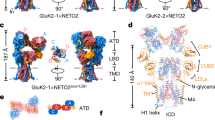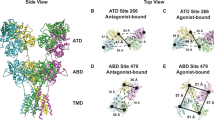Abstract
KAINIC acid is a potent neurotoxin for certain neurons1. Its neurotoxicity is thought to be mediated by an excitatory amino-acid-gated ion channel (ionotropic receptor) possessing nanomolar affinity for kainate2. Here we describe a new member of the rat excitatory amino-acid receptor gene family, KA-1, that has a 30% sequence similarity with the previously characterized α-amino-3-hydroxy-5-methyl-4-isoxazole propionic acid (AMPA) receptor subunits GluR-A to -D3–5. The pharmacological profile of expressed recombinant KA-1 determined in binding experiments with [3H]kainate is different from that of the cloned AMPA receptors and similar to the mammalian high-affinity kainate receptor (kainate > quisqualate > glutamate » AMPA) with a dissociation constant of about 5 nM for kainate2,6. The selectively high expression of KA-1 messenger RNA in the CA3 region of the hippocampus closely corresponds to autoradiographically located high-affinity kainate binding sites7–9. This correlation, as well as the particular in vivo pattern of neurodegeneration observed on kainate-induced neurotoxicity1,2, suggests that KA-1 participates in receptors mediating the kainate sensitivity of neurons in the central nervous system.
This is a preview of subscription content, access via your institution
Access options
Subscribe to this journal
Receive 51 print issues and online access
$199.00 per year
only $3.90 per issue
Buy this article
- Purchase on Springer Link
- Instant access to full article PDF
Prices may be subject to local taxes which are calculated during checkout
Similar content being viewed by others
References
Nadler, V. J., Perry, B. W. & Cotman, C. W. Nature 271, 676–677 (1978).
Coyle, J. T. J. Neurochem. 41, 1–11 (1983).
Keinänen, K. et al. Science 249, 556–560 (1990).
Boulter, J. et al. Science 249, 1033–1037 (1990).
Nakanishi, N., Shneider, N. A. & Axel, R. Neuron 5, 569–581 (1990).
Young, A. B., & Fagg, G. E. Trends pharmac. Sci. 11, 126–133 (1990).
Foster, A. C., Mena, E. E., Monaghan, D. T. & Cotman, C. W. Nature 289, 73–75 (1981).
Monaghan, D. T. & Cotman, C. W. Brain Res. 252, 91–100 (1982).
Unnerstall, J. R. & Wamsley, J. K. Eur. J. Pharmac. 86, 361–371 (1983).
Gregor, P., Mano, I., Maoz, I., McKeown, M. & Teichberg, V. Nature 342, 689–692 (1989).
Wada, K. et al. Nature 342, 684–689 (1989).
Verdoorn, T. A., Burnashev, N., Monyer, H., Seeburg, P. H. & Sakmann, B. Science (in the press)
Gorman, C. M., Gies, D. R. & McCray, G. DNA Prot Engin. Tech. 2, 3–9 (1990).
Hampson, D. R., Huie, D. & Wenthold, R. J. J. Neurochem. 49, 1209–1215 (1987).
Honoré, T. et al. Science 241, 701–703 (1988).
Henley, J. M. & Barnard, E. A. J. Neurochem. 56, 702–705 (1991).
Henley, J. M., Ambrosini, A., Krosgaard-Larsen, P. & Barnard, E. A. New Biol. 1, 153–158 (1989).
Robinson, J. H. & Deadwyler, S. A. Brain Res. 221, 117–127 (1981).
Westbrook, G. L. & Lothman, E. W. Brain Res. 273, 97–109 (1983).
Ben-Ari, Y. & Gho, M. J. Physiol., Lond. 404, 365–384 (1988).
Denetis, E. S., Connolly, J., Rogers, S. W. & Duvoisin, R. Trends pharmac. Sci. 12, 34–40 (1991).
Bettler, B. et al. Neuron 5, 583–595 (1990).
Wisden, W., Morris, B. J., & Hunt, S. P. Molecular Neurobiology: A Practical Approach Vol. 2 (eds Chad, J. & Wheal, H.) 205–225 (Oxford University Press/IRL, Oxford, 1991).
McDonald, J. W. & Johnston, M. V. Brain Res. Rev. 15, 41–70 (1990).
Paxinos, G., Törk, I., Tecott, L. H. & Valentino, K. L. Atlas of the Developing Rat Brain (Academic, San Diego, 1990).
Miller, L. P., Johnson, A. E., Gelhard, R. E. & Insel, T. R. Neuroscience 35, 45–51 (1990).
Represa, A., Tremblay, E. & Ben-Ari, Y. Neuroscience 20, 739–748 (1987).
von Heijne, G. Nucleic Acids Res. 14, 4683–4690 (1986).
Chen, C. & Okayama, H. Molec cell. Biol. 7, 2745–2752 (1987).
Monyer, H., Seeburg, P. H. & Wisden, W. Neuron 6, 799–810 (1991).
Author information
Authors and Affiliations
Rights and permissions
About this article
Cite this article
Werner, P., Voigt, M., Keinänen, K. et al. Cloning of a putative high-affinity kainate receptor expressed predominantly in hippocampal CA3 cells. Nature 351, 742–744 (1991). https://doi.org/10.1038/351742a0
Received:
Accepted:
Issue Date:
DOI: https://doi.org/10.1038/351742a0
This article is cited by
-
PLPP/CIN-mediated NF2 S10 dephosphorylation distinctly regulates kainate-induced seizure susceptibility and neuronal death through PAK1-NF-κB-COX-2-PTGES2 signaling pathway
Journal of Neuroinflammation (2023)
-
Splicing and editing of ionotropic glutamate receptors: a comprehensive analysis based on human RNA-Seq data
Cellular and Molecular Life Sciences (2021)
-
Kainic acid: its tritiation revisited with added technical details
Journal of Radioanalytical and Nuclear Chemistry (2020)
-
Exciting Times: New Advances Towards Understanding the Regulation and Roles of Kainate Receptors
Neurochemical Research (2019)
-
NMDA receptor structures reveal subunit arrangement and pore architecture
Nature (2014)
Comments
By submitting a comment you agree to abide by our Terms and Community Guidelines. If you find something abusive or that does not comply with our terms or guidelines please flag it as inappropriate.



